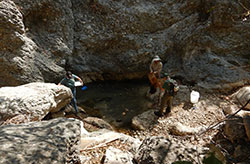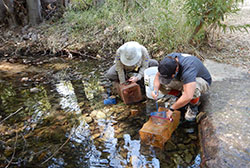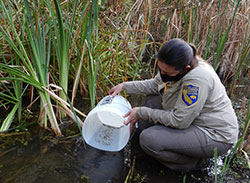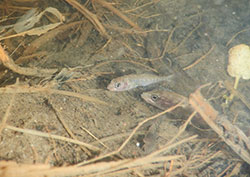Unarmored threespine stickleback

CDFW staff capture UTS from a drying pool in Fish Creek. Click to enlarge

UTS removed from minnow traps in Fish Creek. Click to enlarge

Jennifer Pareti releases UTS into Soledad Canyon Creek. Click to enlarge

UTS released in Soledad Canyon Creek. Click to enlarge
Of the many large wildfires that destroyed millions of acres around California during the 2020, one blaze in particular threatened to wipe out years of fishery conservation efforts. The Lake Fire in Los Angeles County burned more 31 thousand acres and it illustrated – for the second time in four years – what lengths dedicated biologists will go to in order to preserve California’s Unarmored Three Spine Stickleback (UTS). The UTS, Gasterosteus aculeatus williamsoni, is a state and federally listed endangered species and a State of California Fully Protected Species.
The story of this rescue actually began in 2016 when a different fire – the Sand Fire – left multiple feet of sediment settling into Soledad Canyon Creek. CDFW fisheries biologists jumped into action to manually rescue about 150 UTS. The biologists transported the fish to a CDFW hatchery, where they remained for about six months while biologists planned the next move back to the wild. Fish Creek, near Castaic Lake, was selected as an appropriate spot for the relocation, and the biologists were right. The transplanted UTS have been breeding and doing well in that body of water for the last several years.
That’s until part two of this story presented itself. When the Lake Fire presented a new possibility of sediment flow into Fish Creek, the biologists again had to take action. This time, about 300 fish were collected and moved again – this time, in a sense, returning back home.
“When the Lake Fire came across, we watched in horror as the whole upper watershed burned,” said CDFW Inland Fisheries Senior Environmental Scientist John O’Brien. “We knew the situation would be dire as soon as we started getting storms this winter. Once we saw the estimations of the sediment that would come down in the system, it was clear we should take some action. We reached out to our federal partners who co-manage the species with us and we all agreed the best thing to do would be to take some of the fish – as many as we could reasonably get in one day – and bring them back to Soledad, where they came from originally. That habitat has recovered quite nicely (since 2016), so the timing was good.”
O’Brien credited the successful effort to CDFW environmental scientists Jennifer Pareti (the project lead), Russell Barabe and Matt Lucero, as well as scientific aides Marissa Groenof, Mike Stephens, Karen Boortz, Austin Sturkie and Thompson Banez.
“We used minnow traps to trap the UTS, and because we’ve had high heat over the past couple of weeks, we used nets to get them out of small, isolated pools that were drying back,” said Pareti. Like her boss, Pareti was instantly worried about the fisheries impacts when the fire began.
“Honestly, you see these fires start and you watch them take off, and we can only sit on the sidelines (while it’s happening),” she said. “Once the fire is under control, we can get in and start doing the next set of work. We have to look at what we can we do to help the resources. How can we help the fish perpetuate through this giant hurdle that’s ahead?”
Even though it was the same species of fish being moved each time into and then out of Soledad Canyon, it wasn’t literally the same fish. “They’re an annual species, which means they only live about a year,” Pareti explained. “Some of them might live into their second year, but the fish we moved are a generation or two removed from the first batch that was moved in 2016.”
Knowing they’ve helped a species that’s struggled to keep itself going brings great satisfaction to O’Brien and his staff.
“Because of the emergency situation of this fire, we weren’t able to do a really robust and thorough count, but we estimate that we took about 70 percent of the fish that were there,” O’Brien said. “They (UTS) are, along with the Southern California steelhead, the most endangered fish we have in Southern California. Those fish species are literally on the edge of being able to continue to exist. Whenever there’s a threat to a UTS population, we take it very seriously,” said O’Brien.
The team plans to continue to monitor the waters for the UTS – not just those at Soledad Canyon Creek, but also Fish Creek, which will recover from the fire damage naturally over time. “Maybe some of those fish (we didn’t capture) will survive,” said Pareti. “Ideally, that stream will provide a long-term opportunity for this species so we can help to expand the population.”
To learn more about UTS, please visit the CDFW website.
###
Media Contact:
Tim Daly, CDFW Communications, (916) 201-2958
CDFW photos